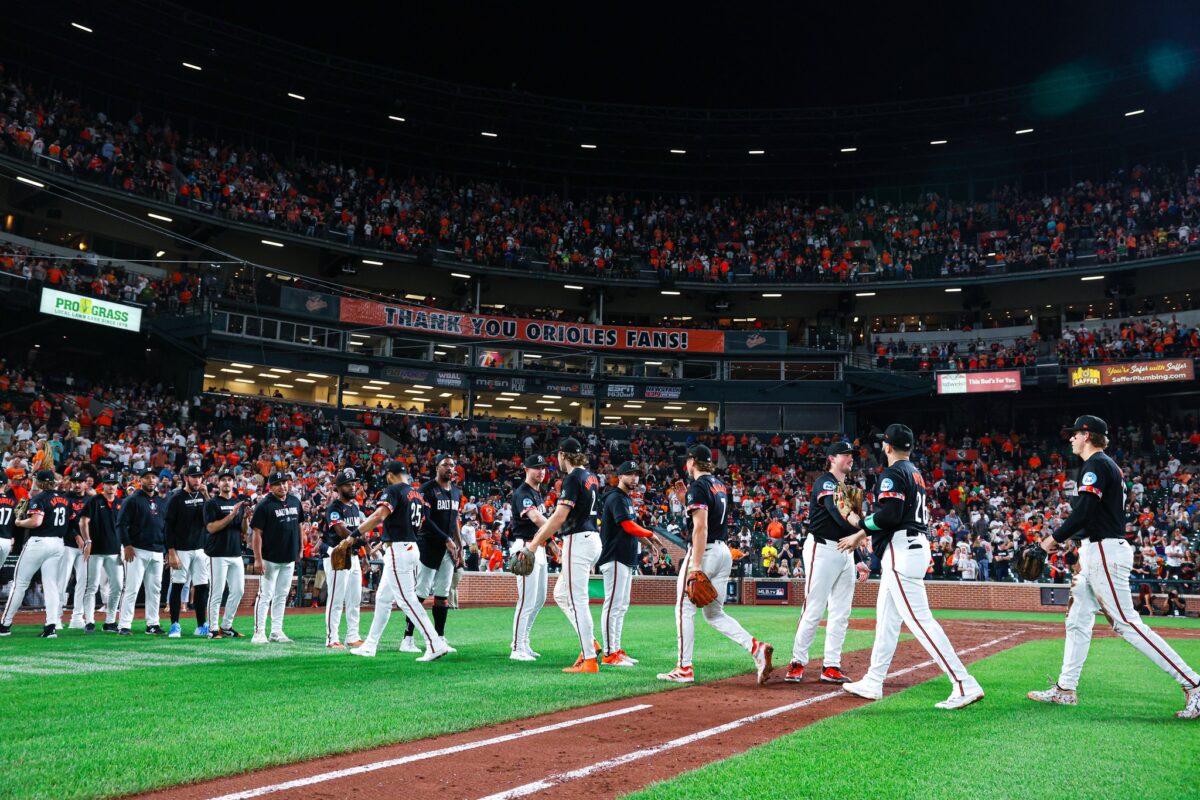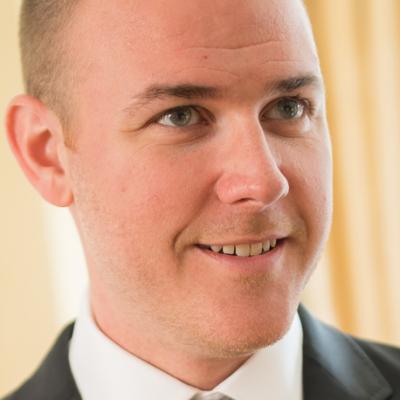
Gunnar Henderson, Adley Rutschman, and everyone else circled the locker room on Wednesday night, slapping hands with each teammate they crossed and seeking out those they hadn’t.
“Love you,” Henderson and Ryan O’Hearn said to each other, hugging.
“Next year,” pitcher Kyle Bradish said to Henderson as he walked another part of the room.
In the meantime, Rutschman’s eyes watered as he meandered from a group of O’s pitchers that included Keegan Akin and Danny Coulombe.
“We spend so long together and here it is in two minutes, the season comes crashing down,” veteran catcher James McCann said near his locker to reporters. “It’s not what we expected. The emotions hit you like a freight train. It happened so quick.”
Again.
For the second straight year, the Orioles hosted a playoff series at Camden Yards in which they were favored—and didn’t win a game.
Last year, the eventual World Series champion Texas Rangers took two at Camden Yards and swept the top-seeded O’s—winners of 101 regular-season games in 2023—from the American League Divisional round. The sweep was easily chalked up to inexperience and not enough pitching.
This time, the fourth-seeded O’s—who won 91 regular-season games—scored just one run in two postseason contests. Cedric Mullins’ solo homer into the right-center field seats in the fifth inning tied Game 2 of the best-of-three Wild Card Series with the Kansas City Royals. Just three batters later, the O’s loaded the bases with no outs on a Ramón Urias single, a Henderson walk, and a Jordan Westburg chopper that Royals starting pitcher Seth Lugo misplayed.
The 36,000 or so fans in attendance at Camden Yards (clearly not a sellout, as evidenced by empty green seats in the left field upper deck) roared with anticipation for more good sights.
But instead came a self-inflicted series of cuts, emblematic of the team’s offensive struggles the day before in a 1-0 shutout loss, and in a 33-33 second half of the season. Anthony Santander popped out. Colton Cowser turned on a 97 mile-per-hour sinker from Royals reliever Angel Zerpa for strike three that fractured Cowser’s left hand. Then Rutschman grounded out to second base. In frustration, Urias tossed his batting helmet halfway down the third base line. Scoring was not in his, or anyone’s, future.
The game—and the season—wasn’t officially over at that point, but it felt like it could be. Then, O’s reliever Cionel Perez surrendered the Royals go-ahead run on a single to Kansas City star Bobby Witt in the top of the sixth. Three innings later, it was really over in a 2-1 loss.
A season that began with so much promise—good vibes and new ownership—but broke down midway through with injuries to pitchers (like Bradish, Grayson Rodriguez, and John Means) and everyday regulars (like Jorge Mateo, Ryan Mountcastle, Westburg, and Urias) was finished. Optimism returned when all but Mateo returned to the lineup a few weeks ago.
The questions about why things went wrong in the postseason—again—began almost as immediately. And nobody seemed to have an answer.
“I don’t know,” O’Hearn said. “It seemed like every time something positive was going to happen, it didn’t…I’m shocked. It sucks. It’s a little bit embarrassing, honestly. Feel like we let the fans down.”
Said McCann: “I wish I could give an answer that made sense.”
Henderson got the closest, citing experience: “The more we’re in it, the better prepared we’re going to be…We’re looking forward to taking that next step. [We’ll] let this sit, and use this as fuel.”
Gunnar Henderson analyzes the end of the 2024 Orioles' run. pic.twitter.com/OqH2gtpUte — Orioles on MASN (@masnOrioles) October 3, 2024
Though nobody on the roster has been around for this entire dubious streak, the Orioles are now 0-10 in the playoffs in the last 10 years. That spans the end of the Buck Showalter era, the start of a years-long organizational rebuild, and now two years of good, if not great, baseball in Baltimore that have ended with similar quick thuds in the postseason.
This time, O’s ace Corbin Burnes, acquired just before spring training in a trade, pitched a spectacular Game 1 going into the ninth inning. But he’s likely headed elsewhere as a free agent with dreams of filthy rich money. “We’ll see what happens,” Burnes said postgame. (Not exactly a strong indication he wants to return to Baltimore.)
The O’s Game 2 starting pitcher, Zach Eflin, was good, as well—providing validation of one of general manager Mike Elias’ trade deadline moves in July to bolster a hurting O’s pitching staff. (Although another trade, sending young talents Kyle Stowers and Connor Norby to the Miami Marlins for one-time All-Star pitcher Trevor Rogers, paid zero dividends, with Rogers being demoted to the minors a month after being acquired and not making a postseason appearance.)
But on Thursday, in a postseason press conference that he said was far too early for his liking, Elias acknowledged that the offensive woes were the “main theme” of the O’s faltering down the stretch, which Henderson said Wednesday night was “something we need to take care of.”
The Orioles left 16 runners on base in the two playoff games, got just six hits overall, and went 1-for-13 at the plate with runners in scoring position. They too often relied on home runs to produce offense throughout the season, rather than driving in runners with hits to all parts of the field.
“Definitely experienced the frustration of that. Who didn’t?” Elias said. “We are going to examine everything about our offensive approach, teaching, the mix of personnel…I don’t believe it’s necessarily all chance.”
“We relied on the homer,” manager Brandon Hyde said. “When you’re facing really good pitching, that’s tough to do.”
In the two playoff games, Henderson and Mountcastle were both 0-for-7 with four strikeouts. Santander was 1-for-8 with two strikeouts. Westburg was 1-for-6 and Coswer was 1-for-7 with three strikeouts, as Royals pitchers kept Orioles’ hitters consistently off balance with a mix of overpowering fastballs and breaking balls weakly hit, if at all.
The most glaring of extended struggles were from Rutschman, who hit .322 in the season’s first month and actually finished with one home run and one RBI less than in 2023. He only hit .132 in July, .229 in August, and .214 in September and October. He was 1-for-8 in the playoff series, and his groundout in the fifth inning of the last game of the season with the bases loaded might gnaw at him for a while.
“I would have gotten a hit,” a bleary-eyed Rutschman replied to someone’s question about what he would’ve done different in the situation. He also alluded to being worn down physically. “I’m going to let my body get right,” he said. Though Elias said there wasn’t a specific injury to speak of with the two-time All-Star catcher and the team’s No. 1 overall draft pick in the 2019 MLB draft. “He’s our guy,” Elias said of the face of the franchise.
That may be true, but now Rutschman—and every other Oriole that’s been around for the last two seasons—has something new to deal with compared to the low expectation days of the rebuild. Now, the Baby Birds have some adult scar tissue (in some cases physically, if not mentally) to deal with heading into 2025, which could add to the challenges of returning to the postseason for the third straight season. (That would be a first for the O’s since 1969-1971, when the team lost two World Series and won one in the span.) And then advancing further.
Not everyone will be back. Next year’s team will look different. Here’s one telling scene: About 45 minutes after the Orioles were eliminated from the postseason, and as the Royals still celebrated on the infield at Camden Yards, Santander sat in the swivel chair in front of his corner locker, perhaps for a final time.
After hitting 44 home runs and playing solid right field, the 29-year-old Santander—a rare holdover from the Showalter era—will likely command a big contract as a free agent. Separate, but related questions remain about potential long-term deals for Rutschman, Henderson, and the O’s young core. While payroll will assuredly increase under the David Rubenstein ownership regime, the O’s likely won’t keep every free agent around in perpetuity.
With that as the backdrop, as the O’s clubhouse started to empty Wednesday night, Santander noticed Rutschman had just performed an all-too-soon season-ending ritual: signing one of his game-worn jerseys as a parting gift at the request of his catching partner McCann. Rutschman tossed the signed jersey over the chair in front of McCann’s locker.
Burnes had just handed Henderson a similar piece of memorabilia: a white No. 39 jersey and with a message in silver marker. Your heroes were trading mementos, expecting they might not see each other for a while.
“Rutsch, don’t forget mine please,” Santander said.
“You want one?” Rutschman replied.
He needed to find another jersey. Henderson pointed him to the equipment room. A few moments later, Rutschman emerged, laid a white No. 35 jersey on a table, and starting writing on the orange lettering—a gift for a friend and an early, yet perhaps merciful, goodbye for the Orioles’ 2024 season.
